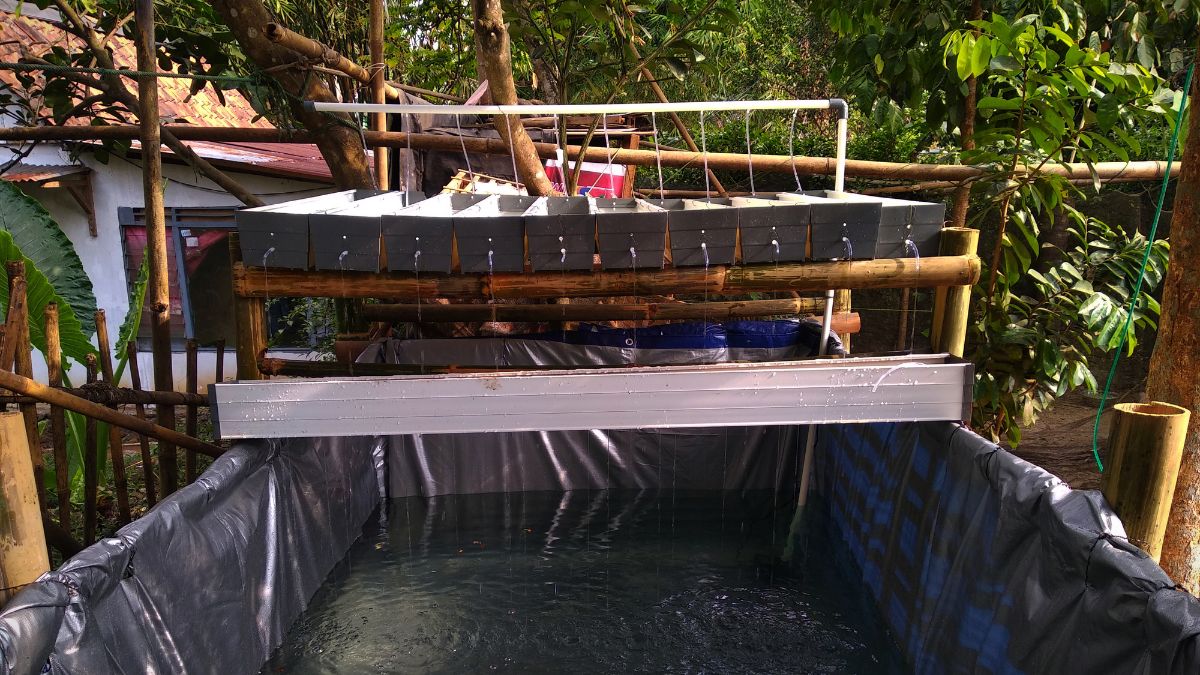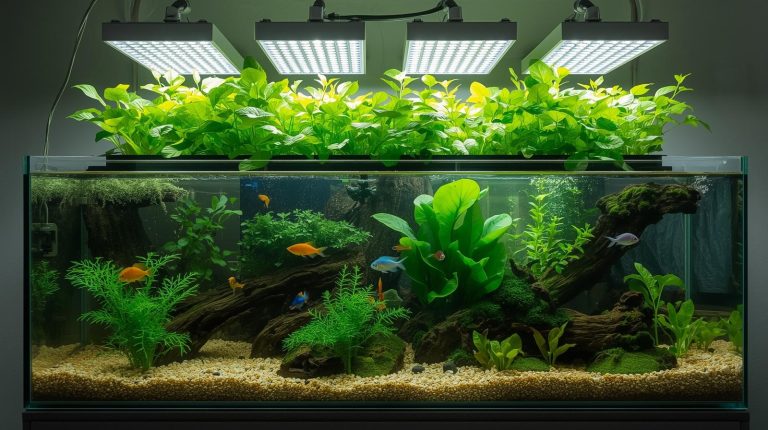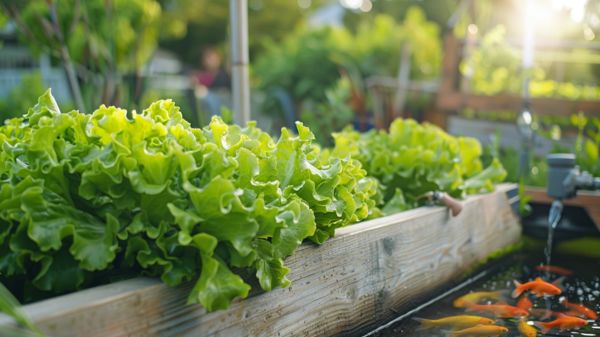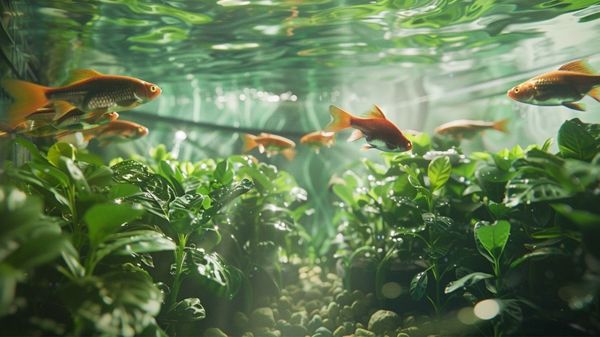Are you looking for a way to be more self-sufficient and grow your own food? DIY aquaponics may be the answer! Aquaponics is a sustainable growing system that combines traditional aquaculture with hydroponic gardening. It uses fish waste as an organic fertilizer to nourish plants, creating a balanced ecosystem where both fish and plants can thrive.
In this article, we’ll cover the basics of aquaponics and provide you with a comprehensive guide on setting up your own DIY aquaponics system. We’ll discuss everything from choosing the right kind of fish and plants, to planning, building, maintaining and even troubleshooting any issues that arise during setup or operation.
We’ll also show you how to maximize profits with aquaponics so that you can get the most out of your sustainable garden!

Introduction to Aquaponics
Get an up-close look at this eco-friendly way of growing plants and raising fish, all in one! DIY aquaponics is a sustainable system that combines aquaculture and hydroponics, allowing you to grow both plants and aquatic animals in one environment.
In aquaculture, the fish are raised in tanks or ponds, while hydroponics uses soil-free systems where plants are grown using nutrient-rich water solutions. The nutrient-filled water from the fish tank is then circulated through the plant beds to give them nutrients for growth. This creates a symbiotic relationship between the two systems that keeps both healthy and thriving.
The friendly aquaponics system has many benefits for both its inhabitants and its owner. It helps conserve resources by reducing water usage up to 90%, eliminating fertilizer runoff into waterways, as well as providing an abundance of fresh produce year round.
Additionally, it’s an efficient use of space since multiple crops can be grown in just a few square feet – perfect for those with limited outdoor space or living situations like apartments or condos. With these advantages, it’s easy to see why DIY aquaponics is gaining popularity among home gardeners looking for an eco-friendly way to grow their own food.
Benefits of an Aquaponics System
Discover the delightful dividends of a dynamic aquaponics setup! An aquaponics system is an integrated approach to sustainable food production that combines fish and plant cultivation in an enclosed, symbiotic environment. This style of gardening offers many benefits over traditional soil-based growing methods.
For example, since aquaponic systems are so efficient with water usage, they help conserve resources and create much less waste than traditional soil-based farming techniques. Additionally, they use fewer chemicals than conventional farming, making them more environmentally friendly. With an aquaponics diagram, you can easily visualize the entire process from start to finish and see how it all works together.
DIY aquaponics plants can be grown in any sized space–from small aquariums to large tanks–making for a great way to enjoy fresh produce in your own home or backyard year round. You don’t need a green thumb or special expertise to get started either; even if you’re new to gardening, building your own aquaponics fish tank diy is easy!
Plus it’s cost effective too; one time setup costs are minimal compared with long term savings from reduced water consumption and chemical inputs. After following this comprehensive guide on building your own sustainable system, you’ll be ready reap the rewards of DIY aquaponics!
Fish Selection for Aquaponics
Experience the joy of cultivating your own aquaponics system with a fish selection that perfectly complements your plants! Choosing the right type of fish for your aquaponics system is essential to its success, as the health of your plants and the safety of your fish are both dependent on it.
There are a variety of different aquaponics fish species you can choose from, so it’s important to understand which ones will work best in your environment and what practical considerations should be taken into account.
For example, some common best fish for aquaponics include tilapia, goldfish, catfish, perch and koi. Tilapia tend to be one of the most popular choices due to their fast growth rate and hardiness. Goldfish also make great additions to an aquaponics system since they have low oxygen requirements, but they reproduce quickly so you may have too many if not monitored properly.
Catfish are bottom-feeders that help keep algae levels down and provide additional nutrition for other species in the tank. Perch are a higher maintenance option since they require frequent water changes but can be rewarding when cared for correctly. Koi can bring lots of color to an aquaponics system but require larger tanks than other species and need more filtration due to their waste production level.
With careful consideration of these different aspects along with other practical aquaponics factors such as tank size or temperature needs, you’ll be able to select a few species that will thrive in your setup! Moving onto plant selection for aquaponics…
Plant Selection for Aquaponics
After you have carefully selected the right fish for your aquaponics setup, it’s time to pick out your plants – and as the saying goes, variety is the spice of life! Here are some of the best plants for aquaponics:
- Leafy greens, such as lettuce and spinach, which grow quickly and can be harvested multiple times.
- Herbs like basil, parsley, cilantro, and thyme.
- Root crops such as carrots or radishes that do well in an aquaponic system due to their ability to produce nutrient-dense underground tubers.
When selecting plants for aquaponics it is important to think about what you want in terms of yield size, flavor profile, growing rate and harvest time frame. Also consider which types of plants require more care than others when selecting your specific plant varieties.
With careful consideration these factors will help ensure you create a vibrant aquaponic garden with plenty of fresh produce! Now that you’ve chosen your fish and plants it’s time to plan out and build your sustainable system. Learn how to grow vegetables in aquaponics system.
Planning and Building Your Aquaponics System
Get ready to take the plunge and create an eco-friendly, self-sustaining ecosystem with your own aquaponics setup! Planning and building your aquaponics system requires careful consideration of a few key factors. To start, you’ll need to determine what type of aquaponic system is best for you: will it be a flood and drain aquaponics system, or a continuous flow system?
Once you’ve decided on the type of aquaponic system that best suits your needs, you can move onto determining the size of your tank and raft bed. The size of these components should match up with the amount and type of fish you plan to keep in your aquatic environment.
Since this is a DIY project, you’ll need to consider how much time and effort you’re willing to put into creating an efficient aquaponics setup. Aquaponic diy plans are available online that provide detailed instructions for setting up different types of systems – these may come in handy when assembling everything from scratch.
You’ll also want to make sure that all parts are properly fitted together so that there won’t be any leaks once the water has been added; if anything seems off or not secure enough, don’t hesitate to double check before adding any fish or plants into the mix. With careful planning and construction comes a well-functioning DIY aquaponics fish tank!
Maintaining Your Aquaponics System
Once you’ve got your aquaponics system up and running, maintaining it is the key to success – after all, ‘a stitch in time saves nine’! Whether you have a small scale aquaponics system or a homemade urban aquaponics setup, there are certain steps that must be taken to keep your system healthy and productive.
The first step is to regularly check for any signs of damage or malfunctioning components. Look for signs of leaking pipes, malfunctioning pumps, clogged filters and any other issues that could disrupt the water flow or put excessive stress on the fish. Additionally, inspect your plants often for signs of nutrient deficiency or pests which could affect their growth.
It’s also important to regularly top off the water in your tank as some will evaporate over time. To ensure proper maintenance of pH levels in your water, make sure to test it routinely as well. Lastly, clean out any debris such as plant waste or fish excrement from the tank and filter media on a regular basis; this helps ensure that oxygen levels remain high enough for both plant and fish health.
By following these steps you can keep your aquaponics system running smoothly and help avoid common issues down the road. With proper maintenance and care, you can enjoy a successful aquaponics experience!

Troubleshooting Common Issues in Aquaponics
Experiencing some hiccups with your aquaponics set-up? Don’t panic – we’ve got the solutions to help you get back on track! Troubleshooting common issues in aquaponics is an important part of keeping your system up and running. To successfully identify and fix any problems, it’s important to understand the different types of aquaponics systems as well as their individual components.
In most cases, troubleshooting will involve checking for potential power outages or clogs in the water pumps and other sources such as pipes and filters. Additionally, it’s important to check for pH imbalances or nutrient deficiencies that can impact the health of your plants.
By regularly monitoring these aspects of your system, you can quickly diagnose any issues and resolve them before they become a larger problem. With a little bit of know-how and regular maintenance, you’ll be able to keep your aquaponics source running smoothly!
Now that you have an understanding of how to maintain and troubleshoot common issues in aquaponics systems, it’s time to explore how to maximize profits with this unique form of gardening.
Maximizing Profits with Aquaponics
Now that you have all the knowledge and skills to build, maintain, and troubleshoot your aquaponics system, it is time to dive into how to maximize profits with aquaponics.
Aquaponics is becoming a more popular choice among green-minded entrepreneurs who are looking for an affordable and sustainable way to make money while also helping the environment. With careful planning and strategic implementation of designs, aquaponics can be used as a profitable business venture.
When compared to hydroponics systems, aquaponics offers several advantages when it comes to making money. While hydroponics requires additional resources such as water pumps, lights for indoor growing, electricity costs for powering these items and other inputs like fertilizers; in an aquaponic system much of these needs are provided or significantly reduced by natural processes.
Additionally the fish component of an aquaponic system acts as a year round source of income due to its ability to be farmed for food or recreational purposes.
To maximize profits with your aquaponic setup:
- Start by researching local laws pertaining to selling produce from your own home garden or farm operation.
- Focus on highly marketable crops that require minimal effort (i.e., lettuces) but yield high returns when sold at farmers markets or restaurants.
- Utilize effective marketing techniques such as creating professional website/social media presence with attractive visuals and content that draws customers in.
- Expand production gradually so you can become more familiar with customer demand before investing too much capital in equipment upgrades or expansions.
- Become educated about common pests/diseases associated with each crop type so you can quickly identify problems early on and take corrective actions if needed before they spread throughout the entire system resulting in losses due financial commitments made prior harvesting cycles (seeds/plants purchased etc.).
Is Aquaponics Right for You?
If you’re looking for an affordable, sustainable way to make money while helping the environment, aquaponics could be the right choice for you. With the right setup and maintenance, it can provide a steady source of income with minimal input.
Aquaponics is a self-sustaining system that uses fish waste as fertilizer for plants, and in turn, the plants clean and filter the water used by the fish. This means that you don’t have to buy extra fertilizer or water to run your system. Additionally, aquaponic systems are easily scalable and customizable – they can range from small-scale backyard setups to large commercial operations.
Aquaponics also require less labor than traditional farming methods. As long as you keep up with regular maintenance tasks like cleaning filters and replacing light bulbs periodically, running an aquaponic system is relatively low effort compared to other types of agriculture.
Additionally, because it operates indoors in controlled environments year-round, there’s no need to worry about unpredictable weather conditions or seasonal fluctuations affecting your crops. Ultimately, if you’re looking for a low-maintenance way of earning some extra income while doing something good for the planet – aquaponics could be just what you’ve been searching for!
Frequently Asked Questions
How much space do I need for an aquaponics system?
When it comes to aquaponics, the amount of space you need depends on what type of system you are looking to build. Generally speaking, a small home-based setup needs at least 10 square feet of grow bed space, while a larger commercial system requires anywhere from 500–2,000 square feet or more.
Additionally, there should be enough room for equipment such as pumps and filters. If your goal is to produce food for your family or business, you must factor in the kind of fish and vegetables that will be grown in the system. Lastly, consider airflow and lighting when deciding how much space is necessary for an aquaponics system.
How often do I need to feed the fish?
Are you wondering how often to feed your fish in your aquaponics system? A good rule of thumb is to feed them twice a day, once in the morning and then again at night. Make sure not to overfeed them as this can cause problems with water quality and increase the likelihood of diseases.
It’s important to find a balance between feeding enough so that they are getting their nutritional needs met but also not overfeeding which will put additional strain on the system. Monitor the amount of uneaten fish food that accumulates at the bottom of the tank to make sure you’re feeding just enough for them.
How much energy does an aquaponics system use?
The amount of energy required to run an aquaponics system depends on the size, complexity, and components of the setup. Generally speaking, larger systems require more energy than smaller ones.
In addition, certain equipment such as pumps and lights can be power-hungry if used in greater frequency or for longer periods of time. You’ll need to consider these factors when deciding how much energy your aquaponics system will use.
What is the best temperature for the water in an aquaponics system?
The best water temperature for an aquaponics system will depend on the type of fish and plants you are growing. Generally, warmwater fish prefer temperatures between 68°F to 78°F while coldwater species like trout need temperatures below 68°F.
Plant growth is usually optimal with temperatures between 65°F to 75°F. For most systems, however, it’s important to maintain a constant temperature without large fluctuations. To ensure this, make sure your tank is in a location that can be easily regulated and consider investing in a thermostat or chiller device.
How often do I need to clean the system?
Cleaning your aquaponics system is an important part of keeping it running efficiently and effectively. Depending on the size and complexity of the system, you should plan to clean it every one to three months.
During this time, you will need to remove any algae buildup, empty and rinse containers or grow beds that are used for growing plants, check all pumps, air stones, distribution tubing and filter media for clogs or debris build-up, replace water if necessary, and test the water for pH levels.
Taking these steps will help keep your system running smoothly so that you can enjoy its benefits for years to come.
Summary
You may be wondering if aquaponics is right for you. The answer depends on your goals and the resources at your disposal. If you are looking to grow fresh, sustainable produce with minimal effort, then yes, aquaponics is a great option for you.
However, it does require some planning and setup time in order to maximize profits from the system. The good news is that there are plenty of resources available online to help guide you through every step of creating your own aquaponics system.
Once it’s up and running, you’ll reap the benefits of having a self-sustaining ecosystem producing healthy, delicious food!




